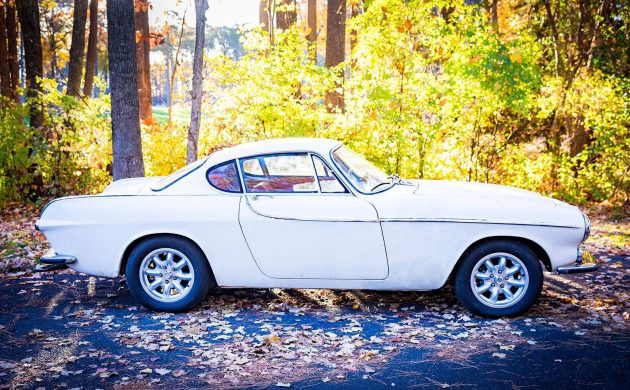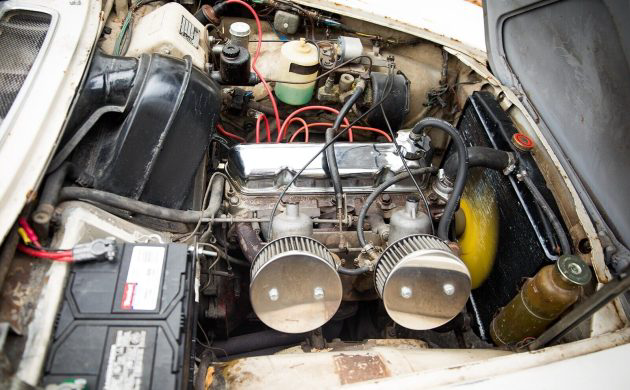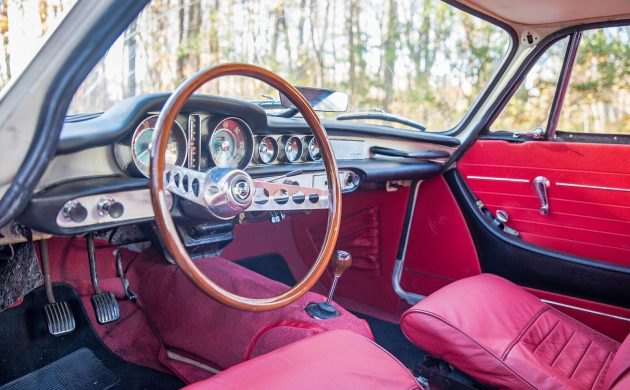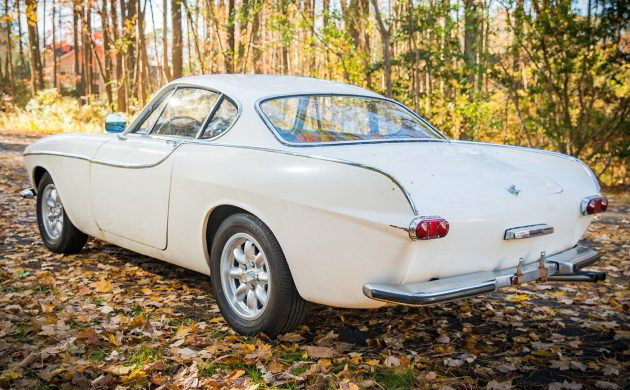I will honestly raise my hand and admit that I was never a fan of Volvos. I saw them as staid and boring cars from a company that traded more on its safety credentials than its performance prowess. This view was borne out of ignorance because once I’d sampled a couple, I realized there is more to these classics than meets the eye. A perfect example of the company’s unusual approach to product development is the 1800S. This model nearly didn’t happen, and when it did finally appear, it was plagued by quality control issues beyond the company’s control. Volvo brought the entire program in-house in 1963, and the 1800, in various forms, continued rolling off the line until 1973. This 1966 1800S shows promise as a project candidate at first glance, although scrutinizing the photos suggests it might harbor a hidden secret. That possibility hasn’t dampened enthusiasm since the seller listed it here on eBay in Berlin, Maryland. Bidding has raced to $5,100, which falls short of the reserve.
The story of the 1800 is quite convoluted, with the first hand-built prototype appearing in 1957. Ongoing development meant the car was ready for production by late 1958, but Volvo realized it lacked the expertise to build a sports car. It approached several companies to act as external construction contractors and was on the verge of signing a contract with Karmann when fate stepped in. Volkswagen was Karmann’s largest customer, and they didn’t look kindly upon it churning out a vehicle that directly competed with its Ghia model. All seemed lost until Jensen stepped up to the plate. Volvo felt confident that its history of sports car production would make it an ideal partner in the venture. Unfortunately, that confidence was misplaced because Jensen’s quality control issues and antiquated production techniques meant that between the 1961 launch and 1963, when Volvo brought production in-house, only 6,000 examples of the P1800 were built, and not particularly well. When Volvo assumed total control, the model designation changed from P1800 to 1800S, denoting that the cars were now built in Sweden. This 1800S rolled off the line in 1966, with its original owner ordering it in Pearl White. It makes a positive first impression, with no evidence of significant panel bumps or bruises. A closer inspection reveals it might hold some surprises for its new owner, which may not be pleasant. Rust is developing in the rear valance, and the seller admits to small holes in the hood. However, they might be the tip of the iceberg. There is evidence of repairs and filler in the front rocker on the passenger side, which is worrying. This is a known weak spot in the Volvo’s body, and because the area is triple-skinned and crucial for structural integrity, repairs must be performed to a high standard. The rough appearance of the visible repairs doesn’t fill me with confidence. Similar problems appear to be developing on the driver’s side, leading me to suggest that an in-person inspection is warranted. Some trim pieces require restoration, and the windshield must be replaced or polished to remove visible wiper marks, but the Minilite wheels help to emphasize the car’s sporting credentials.
The drivetrain combination Volvo chose to power the 1800S doesn’t sound exciting, but these cars can pack a surprise. Its engine bay houses a 1,778cc “B18” four-cylinder motor that sends 115hp and 112 ft/lbs of torque to the rear wheels via a four-speed M41 manual transmission with the optional Laycock de Normanville overdrive unit. Everything sounds modest, but with the 1800S tipping the scales at only 2,491 lbs, performance is far better than most people might expect. It is also worth noting that the B18 is one of the hardiest engines you will find, and they still see regular service in domestic rally competition over five decades after the company produced the last one. The seller indicates this 1800S runs and drives, but potential buyers shouldn’t consider it roadworthy. The brakes require attention, while a total inspection and comprehensive service and tune-up should be anticipated before it returns to its rightful place on our roads.
The news becomes more favorable when we turn our attention to this Volvo’s interior, although it still requires a degree of love to present at its best. The seller cleaned the gauge faces and glass, which are now in as-new condition. The dash is tidy, the pad is crack-free, and there is no ripped or torn upholstery. The beautiful Mahogany wheel and matching AMCO shifter knob add a touch of restrained class, and apart from the heater, are the only luxury appointments inside this classic. Okay, now for the tasks awaiting the winning bidder. The carpet fit is poor, especially around the driver’s feet. Addressing this shortcoming should only cost time as the new owner adjusts and tweaks it for a better fit. The front seats feature new covers, but the fit looks quite “baggy.” Removing and refitting the covers might produce a better result, although budgeting for new foam might be wise.
The 1966 Volvo 1800S is one of the unsung heroes of automotive history because it demonstrates that Volvo possessed sporting credentials before cars like the 850R rolled off the line. I want to genuinely like this one, and I want a new owner to return it to its former glory and rightful place on our roads. Would I buy it? That’s a tough one to answer, but I wouldn’t commit either way before undertaking a thorough inspection. The visible repairs in the rockers ring alarm bells, and I would want to clarify the situation to ensure I wasn’t biting off more than I could chew. That hasn’t dampened enthusiasm, with twenty-four bids submitted at the time of writing. Could you be tempted, or are there too many questions for your liking?







Rust may be the big issue here but power and driveability isn’t included. The engines are rock solid and the 1800ES that I raced for a couple years had 226 hp and cleaned house on SCCA events. Wouldn’t put too much money into this one.
Don’t ask me about the picture… it’s right side up on my end. Edit feature would be nice.
Nice car, Bob!! Even if I have to turn it sideways to see!
FWIW, bobhess-When you tap on the picture it show the full scene even tho it’s still sideways.
All of your race cars you’ve shown us here look like something we’d expect to see driven by Peter Brock or Bob Tullius (sp?).
Nicely done.
Thank you. That’s the way we build them.
Unrelated… pic is small, but your avatar looks like a Waco CG-4A… My Dad flew those… and lived to tell the stories.
I always thought Volvos (and SAABs) were uber cool…this to me is a Karmann-Ghia, with even more style.
👍🤓
Ugh those lower fenders and rockers look like a thick Bondo job
Love old Volvos have owned 5 started with a 64 544 b18 sport fun car but the floors rusted through
Went to a 2 door Amazon ok but not as fun the a 69 142 with overdrive British racing green with buck interior spent a year getting it to rally spec and my older sister borrowed it ran a red light and totaled it. Then went to a 70 1800 s which was sweet car wish I had not sold it but fell in love with a fiat spider fun car but no where near the car the 1800 s was
My dad was service manager at Volvoville on long Island in Amityville
Designed the 1st under dash A/C and Convertible top on the p1800
1st car I learned to drive stick was his 61 P1800!!
I .ike those, but nice examples are really spendy.
Roger Moore as The Saint drove one, and he was cool to my youthful eyes, so his car was, too.
As far as those engines, I had a Volvo 122S with the same motor in college, and an entire drunken fraternity could not kill it.
I’d put one in my garage if I could find a solid example in my budget. I might as well hope for a split-window C1.
I always wanted a 72-3 1800ES . A Wagon.
A fellow in my town had the classic green wagon with overdrive! To boot, it had a metal sunroof that was added by the dealer as a special order. I like to have died and gone to heaven. Anyway…as I remember I drove it around and I think the price was 3500 bucks…this was the late nineties…..and was willing to seal the deal when the owner changed his mind. I couldn’t blame him.
I had a cousin who told his boss at the time that he was a “mechanic.” Boss gave him his 1800 to work on. Somehow, the hood was removed. When said hood was reapplied? He couldn’t get it to close. Much hilarity, and blue language ensued, as my cousin jumped up and down on the hood, in frustration. Needless to say, a new hood, with a paint job, provided by my uncle, was in store.
I had a 1967 1800s when I was in college.
The front fenders on these are WELDED ON, not bolt on. Replacing a fender is a major undertaking.
The roof is a double layer of steel, with a gap between them.
The 1800s has a gas filler door located on the top of the trunk area, between the fin and the trunk opening: if the drain hole gets clogged, the gas tank (rather quickly) fills with water.(this was changed on the 1800E, which relocated the filler to the side of the back fender.
Rust is certainly the enemy on these cars!
If you like driving with your elbow on the windowsill, you’ll find that the sill is very high. Mine didn’t have A/C, and the window was usually open.
All said and done, I would love to add one of these to my collection!